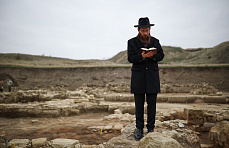
World's Oldest Synagogue Found to Be Part of Ancient Jewish Quarter

15 November 2024
The Volnoe Delo Foundation has announced the findings from the latest excavation season by the Phanagoria Archaeological Expedition. Continuing their research of the ancient synagogue unearthed last year, the archaeologists concluded it was part of a larger Jewish quarter, which included a winery, garden, residential houses, and public buildings.
The ancient Phanagoria synagogue was built no later than the early 1st century AD and was destroyed by barbarian tribes in the 6th century. It was located in the city's most affluent neighbourhood, at the junction of two main streets. It featured opulent architectural features, with the columns, a table for Torah readings, menorahs and bas-reliefs all crafted from imported marble. The synagogue was part of Phanagoria’s Jewish quarter, which also included a vineyard, a garden with clay pithoi used for irrigation, various buildings, and a water distribution network.The eastern section of the synagogue housed the Torah ark, while the western area served as a space for ceremonial feasts and receptions of foreign guests. Among the remains of the floor, cracked open by the invaders back in the day, 58 copper coins were discovered. Some were found near the bimah, benches, and the threshold, in line with the Jewish tradition to protect the synagogue against the evil eye ('ayin ha-ra'). A few more were located near the lid of the alms receptacle ('tzedakah').
The Jewish community in Phanagoria was one of the largest in the Mediterranean region, as evidenced by numerous tombstones bearing Jewish symbols. These often depict a seven-branched candlestick (menorah), a horn (shofar) and a palm branch. A unique find by the Phanagoria expedition was an amphora with a Hebrew inscription on its seal, translating to 'God:justice'. It is believed that such amphorae were used by wandering Jewish merchants, the Radhanites, to import kosher food to Phanagoria.
Several Jewish manumissions dating back to the 1st and 2nd centuries AD were also discovered in the Jewish quarter. These documents granted freedom to slaves on the condition that they continue serving at the synagogue. This missionary work allowed the Jewish community to ensure safety during times of persecution against Jews. “The Jewish community of that time adhered to all the laws and traditions of the Jewish people, while also respecting local customs and striving to create comfortable lives for everyone,” noted Menachem Mendel Lazar, Chief Rabbi of Krasnodar and the Krasnodar Territory. “This reflects the wisdom of our sacred Talmud: ‘When you come to a city, do as the locals do.’”
In the 6th century, Phanagoria was raided by a neighbouring barbarian tribe. During the attack, the invaders used palintonon-type throwing machines to hurl stone balls at the city. Most of the projectiles were discovered near the synagogue, suggesting that the Phanagorians sought refuge behind from the relentless bombardment. The city was completely destroyed and remained in ruins for 130 years before being restored. From the 7th to 9th centuries, until the city’s eventual decline, Judaism was one of the state religions of the Bosporan Kingdom, to which Phanagoria belonged.

